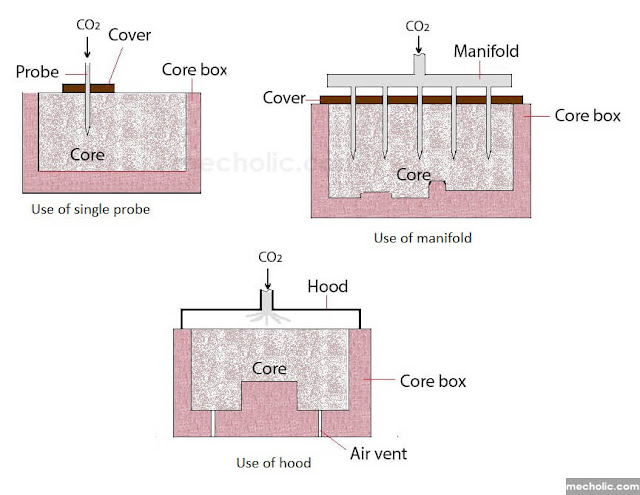What Is Carbon Dioxide (CO2) Moulding Process? Application Advantages and Disadvantages
🔗 Types of mould material - green sand, dry sand, skin dried, loam, metal mould
🔗 Comparisonbetween green sand moulds and dry sand moulds
How Carbon dioxide moulding is done? The principle behind it
CO2 moulding (Carbon dioxide moulding) is a unique moulding process. This is essentially a quick moulding process. Here liquid sodium silicate is used as a binder instead of clay in the conventional sand moulding. The principle behind the CO2 moulding process is that when CO2 passes through a sand mix containing liquid sodium silicates binder for two-three minutes, it immediately gets hardened by silica gel formation. The silica gel (SiO2.x.H2O) is formed by the chemical reaction between sodium silicate and carbon dioxide. This silica gel gives the strength sufficient to eliminate baking/ drying of mould.
The sand used must be dry and free from clay. GFN of sand grains is in the range of 55 to 85. The sand is mixed with 3-5% of sodium silicate. Some other additives, such as coal powder, wood floor, Dextrin, iron oxide, aluminium oxide etc., are also added to obtain specific properties. Dextrin, coal powder and wood flour improve collapsibility. Aluminium improves the hot strength of sand at 800°C. Iron oxide helps to prevent the deformation of cores, and it produces a smooth interface between mould and metal, thus helping to get a good surface finish.
The gassing of co2 into the mould can be carried out in different ways (gassing with a probe, gassing with a hood) depending essentially on the mould’s size. The flow rate, time of gassing and pressure of CO2 gas depends on the depth of penetration required. Usually, gassing time is within 15 to 30 seconds. The mould must be used within 12hours; otherwise, it starts to absorb water from the atmosphere and deteriorate.
The chemical for this reaction is given below
Na2O . mSiO2 . xH2O + CO2 —> Na2CO3 + mSiO2 . xH2O
After passing carbon dioxide, the pattern is removed, and the mould is ready to pour molten metal immediately into it. This eliminates the headache of foundrymen's need for greater skill and caring during mould-making and baking.
Application of carbon dioxide moulding
- Nowadays, it is used to make cores for conventional mould instead of complete mould.
- Production of heavy and thick-walled steel casting. There is no weight limit.
- Production of cast iron, steel, aluminium, and copper-based alloy casting.
- For making of larger cores of heavy ferrous casting.
- Used for making parts of valves engine, machine tools railway casting, gear casting wheel casting
Advantages of carbon dioxide moulding
- The method is versatile. It can be used in small and large foundries for light and heavy casting and ferrous and non-ferrous foundries alike.
- Does not require core drier or baking process. It saves time and cost for heating and floor space.
- Withdrawal Pattern is facilitated since the mould immediately hardened.
- Less mould cracking and deformation. Low mould rejection.
- Since it does not involve any distortion due to baking, better dimensional accuracy can be achieved.
- Machining allowance can be reduced.
- It has high strength, so it does not require other reinforcement.
- Semi-skilled operator is required compared to dry sand moulding
- Process good strength and hardness.
- The process can be mechanized for mass production.
- Molten metal can be immediately poured in to mould and hence reduce the production time
Disadvantages or limitation of carbon dioxide moulding
- The mould is expensive
- One of the main disadvantages of CO2 moulding is that used sand mixture cannot be recovered easily. An expensive and difficult reclamation process is necessary.
- CO2 moulding is less suitable for non-ferrous casting and thin-walled casting.
- The life of the mould is short. Mould should use within 12 to 24hr.
- Poor collapsibility.
- CO2 cores are susceptible to moisture.



